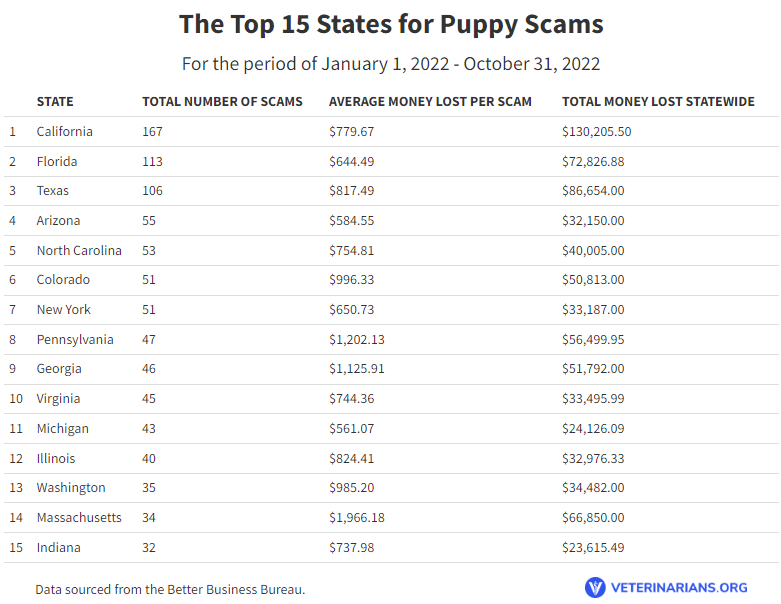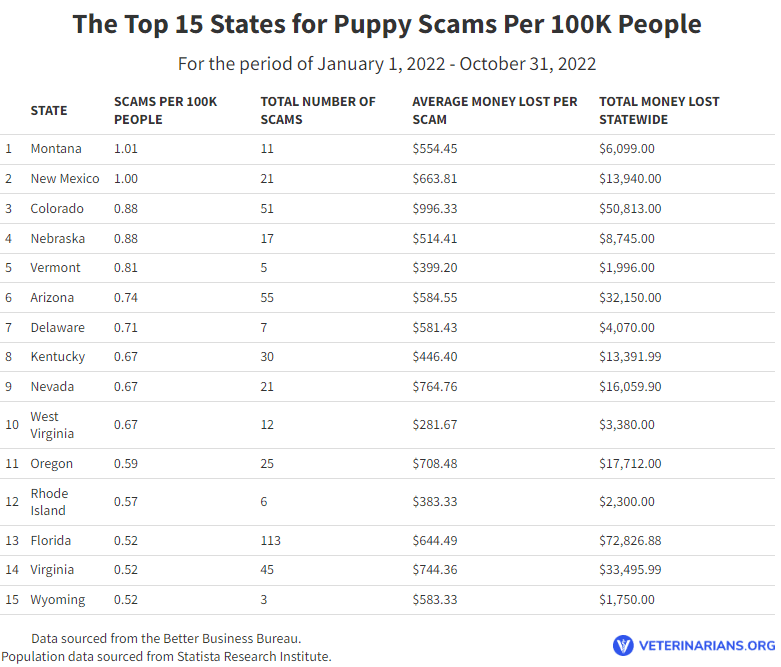Puppy for Sale: The States with the Most Puppy Scams (2022 Ranking)

Table of Contents
So far in 2022, over 1400 puppy scams have been reported to the Better Business Bureau, and experts at Veterinarians.org say this number will only increase as the holidays approach—a time of year when online searches for puppies for sale traditionally see a steep increase.
In this report, we review the Top 15 states for puppy scams overall, the Top 15 states for puppy scams per 100K people, and the average number of money lost per scam victim in these states.
Puppy for Sale—The States with the Most Puppy Scams: Highlights
- The state that has lost the most money to puppy scams so far in 2022 (January 1-October 31) is California, with a total loss of $130,205.50. Texas ($86,654.00) and Florida ($72,826.88) come in second and third.
- The state with the highest average amount of money lost per puppy scam victim is Massachusetts, with victims losing on average $1,966.18. Pennsylvania comes in second at $1,202.13, followed by Georgia at $1,125.91.
- More than half (64%) of the total number of puppy scams in the U.S. come from the top 15 states alone, which together have lost over $769,679 to puppy scams.
- The states with the most number of reported puppy scams are California (167), Florida (113), and Texas (106).
- Florida, Arizona, California, and Virginia not only make the list for the most number of scams in the U.S., but also make the list for the highest number of scams per 100K people.
- The states with the highest number of scams per 100K people are Montana (1.01), New Mexico (1.00), Colorado (0.88), and Nebraska (0.88).
The States with the Most Puppy Scams:Methodology
The Better Business Bureau maintains an archive of all scams reported to the organization since 2015. The archive encompasses all spam types including bank and credit card company imposters, counterfeit products, debt collections, fake invoices, foreign money exchange, identity theft, online purchases, and more.
For the purpose of this study, the Special Reports Team at Veterinarians.org investigated all U.S.-based scam types reported to the Better Business Bureau during the ten-month period beginning on January 1, 2022 and ending on October 31, 2022, which specifically contained the keyword ‘puppy.’ The team studied the number of scams reported per state and the average amount of money lost per scam in each state. Using data from Statista Research Institute, the team also compared each state’s population to the number of scams reported during the specified time frame.
The States with the Most Puppy Scams: Overview
Overall, there were over 1,400 puppy-related scams reported to the Better Business Bureau between January 1, 2022 and October 31, 2022. Using scam data from the Better Business Bureau’s archives and population data from Statista Research Institute, the Special Reports Team at Veterinarians.org analyzed the compiled figures for this study to develop two reports:
1. The Top 15 States for Puppy Scams
2. The Top 15 States for Puppy Scams Per 100K People

More than half (64%) of the total number of puppy scams in the U.S. come from the top 15 states alone, which together have lost over $769,679 to puppy scams.
California is the state with the most reported puppy scams, with 167 scams reported to the Better Business Bureau from January 1, 2022 to October 31, 2022. This makes up more than 10% of the total number of scams reported nationwide.
Collectively, scam victims in California lost over $130,000 during the analyzed time period, with the average amount of money lost per victim totaling $779.67. In terms of most money lost overall, Texas ($86,654.00) and Florida ($72,826.88) come in second and third after California.
Massachusetts, however, stands out with the highest amount of money lost on average per puppy scam. In this state, scam victims lost on average $1,966.18. Pennsylvania ($1,202.13) and Georgia ($1,125.91) follow closely behind.

The Special Reports Team at Veterinarians.org also compared the number of scams reported per state with each state’s population size to analyze where puppy scams are most prevalent based on the number of reports per 100,000 people.
In this study, Montana topped the list with 1.01 scams per 100,000 people. Scam victims in Montana lost on average $554.45 during the analyzed time period.
New Mexico (1.00), Colorado (0.88), and Nebraska (0.88) follow closely behind in terms of number of scams per 100,000 people.
In this ranking, Colorado stands out as the state with the highest amount of money lost per scam, with scam victims losing $996.33 on average. Collectively, scam victims in this state lost over $50,000 to puppy scams from January 1 to October 31, 2022, the second highest amount on this ranking after Florida ($72,826.88).
How to Identify a Puppy Scam: 5 Warning Signs
There are common themes among the reports filed with the Better Business Bureau. These themes can help those who plan to use the internet to search for a new puppy avoid a potential scam. What follows are the most common warning signs among puppy-related scams.
1. The seller claims that you will not be able to see the puppy in person before adoption and/or is unable to provide you with multiple pictures/videos of the puppy up for adoption.
2. The seller asks for payment up front through Western Union, MoneyGram, a digital money app like Zelle or Cash App, or via a gift card.
3. The seller or a third party asks for follow-up payments to cover additional items such as a climate-controlled crate for shipping, vaccinations, or transportation insurance/life insurance. In many cases, fraudulent emails will claim the shipping costs/crate rental fees will be refunded upon the puppy’s delivery. However, they never are.
4. The breeder’s website offers no information about the sire or dam of the litter and/or the breeder is unable to provide proof of health records or AKC Certification.
5. In the case of purebred breeds, the puppy in question is being offered at a significantly steep discount when compared with the average price for a puppy of its breed.
Alternatives to Buying Puppies Online
Despite the ease of searching for a puppy through online marketplaces such as Craigslist and Facebook Market, as well as through independently-owned websites, these platforms are commonly referenced in reports filed with the Better Business Bureau. Those searching for an animal to adopt, therefore, should exercise extreme caution when utilizing such sites, keeping the aforementioned warning signs in mind at all times when interacting with sellers.
There are several alternatives to online platforms when it comes to searching for a new puppy, however. Local animal shelters and rescue groups often boast large numbers of animals that are waiting for a new home. Such organizations allow prospective adopters to interact with their animal of choice in-person to determine the animal’s compatibility with all members of the household. Adoption fees also tend to be significantly lower than what an individual might pay through an online breeder. Adopting from these organizations also helps reduce animal overpopulation in shelters, allowing more animals in need to be taken in and cared for.
For those interested in a purebred pet, it’s long been estimated that anywhere from 20-30% of the dogs in shelters are purebred. There are also numerous breed-specific rescue groups available across the nation. The AKC Rescue Network, for instance, consists of over 400 such groups. Additionally, individuals can search for breeder associations or clubs (e.g. Golden Retriever Club of America, Poodle Club of America, etc.) to find reputable breeders affiliated with the American Kennel Club.
Puppy for Sale: Final Thoughts
Online puppy scams will most likely continue to be an issue across the U.S. However, individuals and families can protect themselves from scams by making themselves aware of the typical warning signs of a scam, and by adopting through an animal shelter, rescue group, or AKC-certified reputable breeder. Raising awareness of such scams can also help to bring an end to them.














